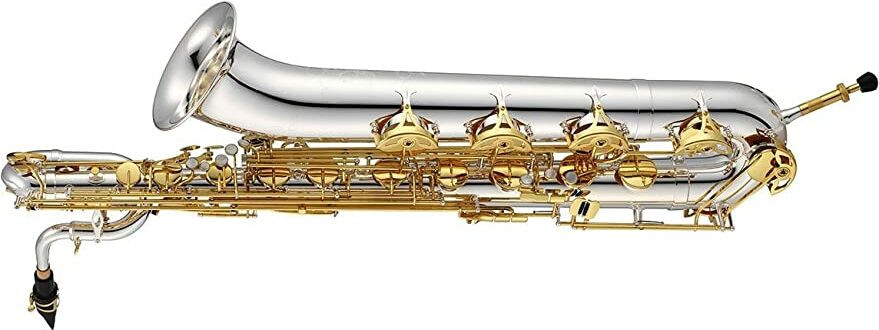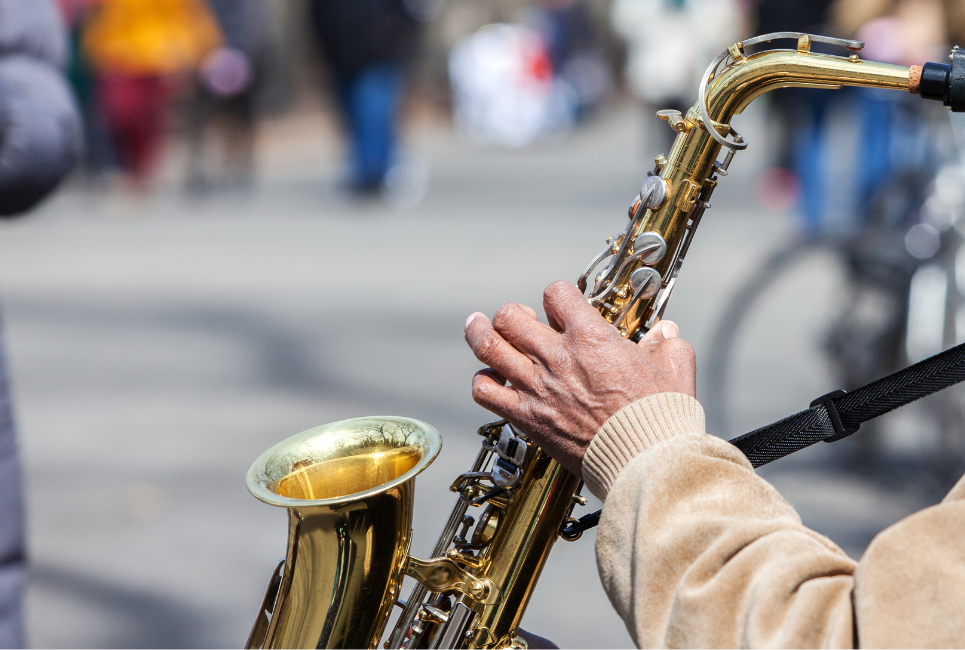- Top Trumpet Embouchure Techniques: Options for Beginners Through Professionals - October 12, 2022
- Is the Trumpet Hard to Learn? - September 30, 2022
- Best Leblanc Clarinet Models Guide: From Soprano to Contrabass - September 5, 2022
Have you wanted to play the tuba but couldn’t get the right brass embouchure? Consider how to find the best subcontrabass saxophone. It’s a great option for woodwind players who want to play as low as possible.
Sadly, it’s not the most common instrument out there. You need to know where to look and be ready to buy as soon as one becomes available.
Consider how you can prepare now to buy yourself a subcontrabass saxophone.
What Is A Subcontrabass Saxophone?
The subcontrabass saxophone is the biggest and lowest-pitched instrument of the saxophone family. Going down from the alto sax, there’s the tenor saxophone and baritone saxophone, which are both common.
Next, you have the bass saxophone, which isn’t as popular, but it’s certainly not as rare. Then, you have the contrabass saxophone and, finally, the subcontrabass saxophone.
It plays an octave below the bass sax and two octaves below the tenor. The subcontrabass requires a lot of air and breath control, so it’s not the best option for students or smaller players.
How To Find The Best Subcontrabass Saxophone
If you want to give the biggest saxophone in the world a try, you should consider how to get your hands on one. Unfortunately, determining how to find the best subcontrabass saxophone is more complex.
The instrument is very rare, so you can’t just hop online or go to your local music store and buy one like you could when learning the alto saxophone. Instead, you need to be able to search a lot and wait for quite a while.
But the wait can be worth it, and you can take steps to decrease the wait. Here are some tips to help you find a good subcontrabass sax.

Play Other Saxophones
The subcontrabass saxophone is not an instrument for beginners. At the very least, you should have some experience playing the alto or tenor saxophone.
Those instruments are easier for learning basic concepts, like breathing, reading music, and fingering different notes. They’re also easier to find and more affordable, so you can learn them from the beginning.
If you have experience with these saxophones, you’ll be able to pick up the subcontrabass without many issues. You will have some differences, such as the size, but the transition won’t be as difficult.
Slowly Work Your Way Down
While you might be successful when switch from the alto to the subcontrabass saxophone, consider playing more members of the family first. You can learn the tenor and then the baritone saxophone.
They’re some of the most common saxophones, so they’re easy to find, and they have plenty of solo and ensemble parts. The baritone sax is a great instrument to focus on if you’re set on learning the subcontrabass.

You can get used to playing the bass line and other low parts, and you can see how you like carrying a big instrument around. If you realize you don’t like the bigger sax, you can switch to something smaller, or you can continue with the bass saxophone.
Build Up Endurance
Use the other low saxophones, like the bari, to work on your endurance. You’ll need to have excellent air support and be able to take big breaths and manage your air while playing the sax.
The bigger saxophones also take some strength to hold and keep in place. Now, you can use a stand to stabilize the subcontrabass, but you need to know if you can get the instrument into position.
If you don’t have enough endurance, you’ll struggle to play even the best subcontrabass saxophone. As you wait for the chance to buy one, you can improve your playing on more common saxes.
Create A Subcontrabass Fund
Once you confirm that you want to get a subcontrabass sax, you should start saving money. These instruments can be expensive because of how rare they are.
You should prepare to spend up to $10,000 or more. And if you find a used one, you might not be the only one looking to buy it. So you might need even more money to give the highest bid.
Save a little money each time you receive a paycheck. Make separate savings account so that you know that money is for your future saxophone and nothing else.
While you can shop around to save money on the instrument, that’s not that practical. You might not see another available sax for months, so having more money ready to spend will help you lower your wait time.
Tell People You Know
Knowing how to find the best subcontrabass saxophone can take a village. While you might find one yourself, it doesn’t hurt to tell people you know about your search.
Tell any musicians and saxophonists in your life that you’re looking for an instrument. You should also talk to your saxophone technician in case they come across one.
It can also help to tell non-musicians you know in case they know another saxophone player. Plus, the more people you tell, the easier it can be to learn about a subcontrabass when it hits the market.
Join Forums And Sales Groups
The internet can be an excellent place to look for your subcontrabass. You can join groups on Facebook and other forum websites for musicians or saxophonists specifically.
Look for instrument sales groups on different websites as well. Then, you can look at the listings regularly to see if there’s an available subcontrabass saxophone.

Many of these forums let you post that you’re interested in buying an instrument. Who knows, you might get lucky, and someone who’s considering selling their subcontrabass might see your post and respond.
Research Subcontrabass Saxophone Makers
Popular saxophone brands, like Yamaha and Selmer Paris, don’t make subcontrabass saxes. In fact, there are only two people in the world that make subcontrabass saxophones or anything resembling the big instrument.
J’Elle Stainer is a Brazilian saxophone maker and the only one that makes a true subcontrabass. However, the instrument is still in the prototype phase, so it’s not available to the public.
Benedikt Eppelsheim also makes subcontrabass saxophones, but they have a different design than what Adolphe Sax intended. The existing design is called a tubax, and it has a smaller bore than the original design.
If you want to get your hands on a subcontrabass, Eppelsheim could be your best option. Or you could contact Stainer and ask for updates on the prototype.
Don’t be afraid to ask these makers when new instruments will be available. It might be a while, but they could contact you when they’re ready to sell you one.
Be Patient
One of the most significant steps in how to find the best subcontrabass saxophone is to have patience. You may get lucky and find one for sale within a few weeks of deciding to buy.
However, you’re probably going to have to wait weeks, months, or even years. On the one hand, that gives you the chance to save up as much money as you can to help afford the purchase.
But it can also be discouraging when you have to wait that long before you can even try the instrument. You might lose interest in playing the subcontrabass, or you might simply get frustrated with the process.
In the meantime, you can brush up on your other saxophones, like the baritone. Then, you can still work on the fundamentals of saxophone playing, which can make the switch easier.
Consider New And Used

Because the subcontrabass saxophone is so rare, you might not have a choice between getting a new and used one. If you’re willing to wait longer, you can prioritize this factor.
Or you might want to prioritize getting any subcontrabass more quickly. Sometimes, that can mean buying a new one if a maker finishes one. In other cases, you might need to buy a used model.
New and used models can be good, as long as the used sax was kept in good condition. Before you buy either, make sure you know someone who can do repairs without you having to ship the saxophone far away.
FAQs About How To Find The Best Subcontrabass Saxophone
Answer: The best true subcontrabass saxophone comes from J’Elle Stainer, even though it’s still in the prototype stage. It follows the designs that Adolphe Sax created when he invented the entire family of saxophones.
However, the best available subcontrabass saxophone comes from Benedikt Eppelsheim. The instrument is technically a tubax as it has a narrow bore compared to the subcontrabass saxophone design. Still, it plays in the same range, so it can be a good option.
Answer: Playing an instrument that large can be a challenge, but it can be fun as well. You can play a lot of low notes, and it can act as the bass line or the melody.
It works well in jazz bands, and you can play any tenor or bass saxophone part on the subcontrabass. You might also see the instrument in a saxophone ensemble, and some avant-garde music calls for the instrument.
https://www.youtube.com/watch?v=9BiW2mVKk0w
Answer: The most famous subcontrabass player is probably Jay C. Easton. He plays every member of the saxophone family, and he also plays a lot of clarinets.
Attilio Berni is another well-known subcontrabass player, and he’s the musician in the video I shared above.
Answer: You need the same basic accessories like any other saxophone. A good mouthpiece and reed are crucial when it comes to making a sound on the subcontrabass sax, but there aren’t specific accessories for the instrument.
Using a baritone saxophone mouthpiece can fit, which is why playing the bari sax a lot can help you prepare for the switch. You can pair it with a baritone sax reed or a reed for the bass saxophone or even the contrabass clarinet.
Another beneficial accessory to have is a stand for the saxophone itself. That way, you can easily take a break without having to lay it down, but the stand can keep it upright while you play.
Answer: The subcontrabass saxophone stands about 9.1 feet (2.8 meters) tall, though the tubing is much longer than that. You’ll need to be strong to move it because it weighs about 45 pounds.
Answer: The subcontrabass saxophone shares the same written range as other saxophones, which is the B flat below middle C to the F or F sharp an octave above the treble clef. This saxophone plays in the key of B flat, like the tenor, soprano, and bass saxophones.
A subcontrabass will sound one octave lower than the bass, two octaves below the tenor, and three below the soprano saxophone. Compared to a piano, the subcontrabass will sound three octaves and a major second lower.
If you convert that to hertz, you’ll find that the saxophone’s lowest note (sounding A flat 0) is 25.92Hz. That’s almost as low as the human ear can hear, where the lower limit is 20Hz.
Answer: You can tune the subcontrabass like any other saxophone. Placing the mouthpiece on the neck in the right spot can help you get the instrument in tune.
Tuning the subcontrabass correctly is crucial because of how low it is. In a group setting, the other players will take your pitch and match it octaves above.
As you tune, make sure your air support stays consistent and that it won’t change when you start playing. If that happens, you can go out of tune and affect the rest of the ensemble.
Final Note On How To Find The Best Subcontrabass Saxophone
If you want to go really low with your saxophone playing, you should consider how to find the best subcontrabass saxophone. The rare instrument can be fun to play, from jazz to contemporary music.
But you can’t use the same shopping methods as you would with an alto or tenor saxophone. From being patient to saving up enough money, keep these tips in mind.
Then, you can try both the Eppelsheim and Stainer subcontrabasses to see which you prefer.



